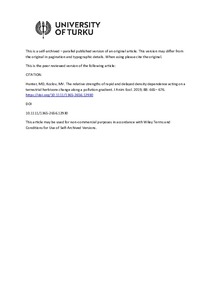The relative strengths of rapid and delayed density dependence acting on a terrestrial herbivore change along a pollution gradient
Mark D. Hunter; Mikhail V. Kozlov
The relative strengths of rapid and delayed density dependence acting on a terrestrial herbivore change along a pollution gradient
Mark D. Hunter
Mikhail V. Kozlov
Blackwell Publishing Ltd
Julkaisun pysyvä osoite on:
https://urn.fi/URN:NBN:fi-fe2021042821882
https://urn.fi/URN:NBN:fi-fe2021042821882
Tiivistelmä
- Animal populations vary in response to a combination
of density‐dependent and density‐independent forces, which interact to
drive their population dynamics. Understanding how abiotic forces
mediate the form and strength of density‐dependent processes remains a
central goal of ecology, and is of increasing urgency in a rapidly
changing world. - Here, we report for the first time that industrial
pollution determines the relative strength of rapid and delayed density
dependence operating on an animal population. We explored the impacts of
pollution and climate on the population dynamics of an eruptive
leafmining moth, Phyllonorycter strigulatella, around a coal‐fired power plant near Apatity, north‐western Russia. Populations were monitored at 14 sites over 26 years.
- The relative strengths of rapid and delayed density
dependence varied with distance from the power plant. Specifically, the
strength of rapid density dependence increased while the strength of
delayed density dependence decreased with increasing distance from the
pollution source. Paralleling the increasing strength of rapid density
dependence, we observed declines in the densities of P. strigulatella,
increases in predation pressure from birds and ants, and declines in an
unknown source of mortality (perhaps plant antibiosis) with increasing
distance from the power plant.
- In contrast to the associations with pollution,
associations between climate change and leafminer population densities
were negligible. - Our results may help to explain the outbreaks of
insect herbivores that are frequently observed in polluted environments.
We show that they can result from the weakening of rapid (stabilizing)
density dependence relative to the effects of destabilizing delayed
density dependence. Moreover, our results may explain some of the
variation reported in published studies of animal populations in
polluted habitats. Variable results may emerge in part because of the
location of the study sites on different parts of pollution gradients.
Finally, in a rapidly changing world, effects of anthropogenic pollution
may be as, or more, important than are effects of climate change on the
future dynamics of animal populations.
Kokoelmat
- Rinnakkaistallenteet [27094]
